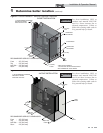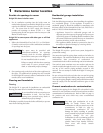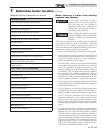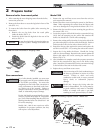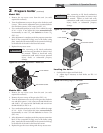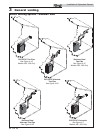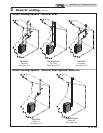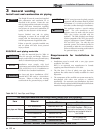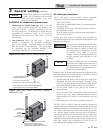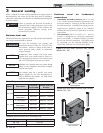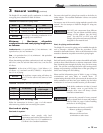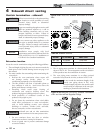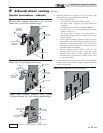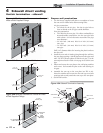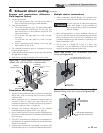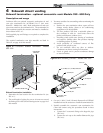
17
Installation & Operation Manual
3 General venting (continued)
Combustion air piping to the outside MUST
BE used. Use of combustion air from the
room via louvers, plenums, or any other
device is not authorized.
NOTICE
PVC/CPVC air intake/vent connections
1. Combustion Air Intake Connector (FIG.’s 3-9 and
3-10) - Used to provide combustion air directly to the
unit from outdoors. A fitting is provided on the unit
for final connection. Combustion air piping must be
supported per guidelines listed in the National
Mechanical Code, Section 305, Table 305.4 or as local
codes dictate.
2. Vent Connector (FIG.’s 3-9 and 3-10) - Used to
provide a passageway for conveying combustion
gases to the outside. Transition fittings are provided
with the unit for final connection. Vent piping must
be supported per the National Building Code,
Section 305, Table 305.4 or as local codes dictate.
6” COUPLING
(FIELD SUPPLIED)
6” CPVC
STARTER
PIECE
(FACTORY SUPPLIED)
VENT
AIR
BOTH THE 6” STAINLESS STEEL ADAPTER
AND THE 6” CPVC STARTER PIECE
SUPPLIED WITH THE BOILER MUST BE
USED FOR VENT CONNECTION TO PVC/CPVC
Figure 3-10 Near Boiler PVC/CPVC Venting -
Models 700 - 800
VENT
AIR
4" CPVC PIPE SUPPLIED WITH
BOILER MUST BE USED FOR VENT CONNECTION
NOTE: CPVC VENT PIPE AND VENT FITTINGS MUST BE
USED IN CLOSET AND ALCOVE INSTALLATIONS.
*
* 4” CPVC STREET ELBOW
MAY BE SUBSTITUTED
Figure 3-9 Near Boiler PVC/CPVC Venting - Models 399 - 600
Air inlet pipe materials:
The air inlet pipe(s) must be sealed. Choose acceptable
combustion air inlet pipe materials from the following list:
PVC, CPVC or ABS
Dryer Vent or Sealed Flexible Duct (not recommended for
rooftop air inlet)
Galvanized steel vent pipe with joints and seams sealed as
specified in this section.
Type “B” double-wall vent with joints and seams sealed as
specified in this section.
*Plastic pipe may require an adapter (not provided) to
transition between the air inlet connection on the appliance and
the plastic air inlet pipe.
ƽ WARNING
Using vent or air intake materials other than
those specified, failure to properly seal all
seams and joints or failure to follow vent
pipe manufacturer’s instructions can result
in personal injury, death or property
damage. Mixing of venting materials will
void the warranty and certification of the
appliance.
NOTICE
The use of double-wall vent or insulated
material for the combustion air inlet pipe is
recommended in cold climates to prevent
the condensation of airborne moisture in
the incoming combustion air.
Sealing of Type “B” double-wall vent material or galvanized vent
pipe material used for air inlet piping on a sidewall or vertical
rooftop Combustion Air Supply System:
a. Seal all joints and seams of the air inlet pipe using either
Aluminum Foil Duct Tape meeting UL Standard 723 or
181A-P or a high quality UL Listed silicone sealant such as
those manufactured by Dow Corning or General Electric.
b. Do not install seams of vent pipe on the bottom of
horizontal runs.
c. Secure all joints with a minimum of three sheet metal
screws or pop rivets. Apply Aluminum Foil Duct Tape or
silicone sealant to all screws or rivets installed in the vent
pipe.
d. Ensure that the air inlet pipes are properly supported.
The PVC, CPVC, or ABS air inlet pipe should be cleaned and
sealed with the pipe manufacturer’s recommended solvents and
standard commercial pipe cement for the material used. The
PVC, CPVC, ABS, Dryer Vent or Flex Duct air inlet pipe should
use a silicone sealant to ensure a proper seal at the appliance
connection and the air inlet cap connection. Dryer vent or flex
duct should use a screw type clamp to seal the vent to the
appliance air inlet and the air inlet cap. Proper sealing of the air
inlet pipe ensures that combustion air will be free of
contaminants and supplied in proper volume.



